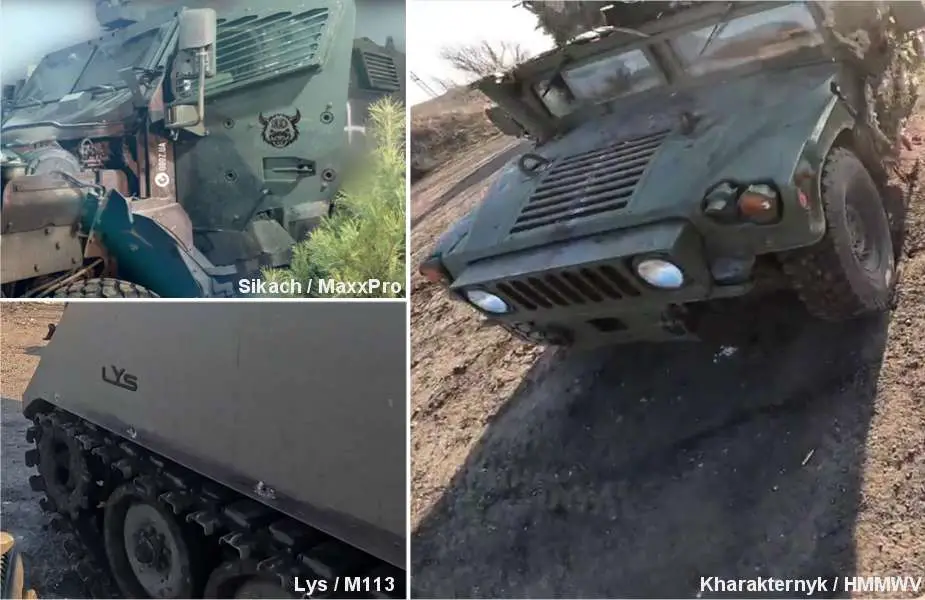- Army
- Conflicts in the world
- Israel - Iran conflict 2025
- Pakistan - India Conflict 2025
- Russia Ukraine War 2022
- Libya conflict day by day
- HAMAS - Israel War 2023
- Operation Serval in Mali French Army
- Sangaris operation Central African Republic
- Sangaris opération militaire République Centreafrique
- Ukraine - Russia conflict
- Syria conflict news
- Defence & Security Industry Technology
- Armies in the world
- Analysis Defense and Security Industry
- Conflicts in the world
- Navy
- Air
Ukraine adapts to supply challenges by replicating US M113, HMMWV, and MaxxPro vehicles
As reported by Defense Express on February 21, 2024, the Ukrainian Armed Forces, confronted with a significant shortage of Western weapons and the uncertainty of further supplies, have developed three new military vehicles named Kharakternyk, Sikach, and Lys. These vehicles, designed as substitutes for the American Humvee, MaxxPro, and M113 respectively, have been deployed across various units of the Security and Defense Forces to address the urgent need for armored vehicles.
Follow Army Recognition on Google News at this link

The Kharakternyk, Sikach, and Lys vehicles, designed as substitutes for the American HMMWV, MaxxPro, and M113 respectively, have been deployed across various Ukrainian units. (Picture source: Ukrainian Front and Oboz.UA)
The vehicles are being produced at a rate of around five per month in various locations across Ukraine, utilizing existing facilities of different enterprises. This initiative, as described by Ukrainian engineers, is more akin to artisanal production than to a full-scale manufacturing line. Despite this, they have managed to produce vehicles that, while closely mirroring their original counterparts, feature distinct technical adaptations suited to local conditions and needs.
The Kharakternyk, an analog of the HMMWV/Humvee, utilizes chassis from the GAZ-66, Ford F-150, or F-350, with a noted preference for the American models due to the easier modification processes. The number of vehicles based on the GAZ-66 chassis remains limited, reflecting the practical limitations within the current manufacturing framework.
The Lys, which aims to replicate the M113, is based on the chassis of the MT-LB armored personnel carrier and the BMP-1 infantry fighting vehicle. Based on current combat experiences, significant alterations have been made to the Lys, particularly in terms of its armor and power plant, to address the M113's vulnerabilities and enhance its performance. This includes the use of a new alloy for armor, diverging from the original aluminum used in the M113, which was deemed unsuitable based on current combat experiences.
The Sikach, developed at the end of 2023, serves as an unofficial variant of the American International MaxxPro Mine Resistant Ambush Protected (MRAP) vehicle. Its usage was documented in February 2024 during the conflict in Eastern Ukraine, particularly during the withdrawal of Ukrainian troops from Avdiivka. The Sikach is armed with a Browning M2 .50 caliber heavy machine gun, weighs up to 25 tons, and can transport up to eight personnel in addition to a crew of two.
The engineers involved in the development have successfully replicated the external appearance of the original Western models, with the vehicles reportedly mirroring their prototypes closely. However, the interior and some technical aspects have been modified according to local needs and available materials.
The production of these vehicles has been undertaken without formal licensing, reflecting a pragmatic approach to wartime manufacturing constraints. The engineers and operators involved acknowledge the expedited nature of this process and express hope for understanding from their American counterparts, particularly considering the challenges posed by supply shortages and legislative hurdles.
Feedback from the operators of these vehicles has been positive, with reports indicating that the new models have performed well under combat conditions. The creation of the Kharakternyk and Lys represents a localized solution to the immediate needs of the Ukrainian defense forces, showcasing an adaptation of available resources and existing capabilities to meet the demands of the current conflict.
Ukraine's defense strategy has shifted significantly towards improving its self-sufficiency in military capabilities, following an initiative started by Ukrainian Minister of Economy, Ioulia Svyrydenko, in March 2023. This shift is aimed at diversifying sources of weaponry and reducing reliance on foreign allies to achieve long-term security independence from Russia post-conflict. In the months following this strategic redirection, there has been a marked transition from the procurement of foreign military assets to a focus on domestic production and technological independence. This strategy aims to provide Ukraine with a consistent and adaptable supply of military equipment, which could lead to a more self-reliant defense posture. The emphasis on domestic production seeks to mitigate risks from external supply chain disruptions and adapt to evolving military needs, to maintain and enhance the operational readiness and effectiveness of Ukraine's armed forces during the ongoing conflict.


























